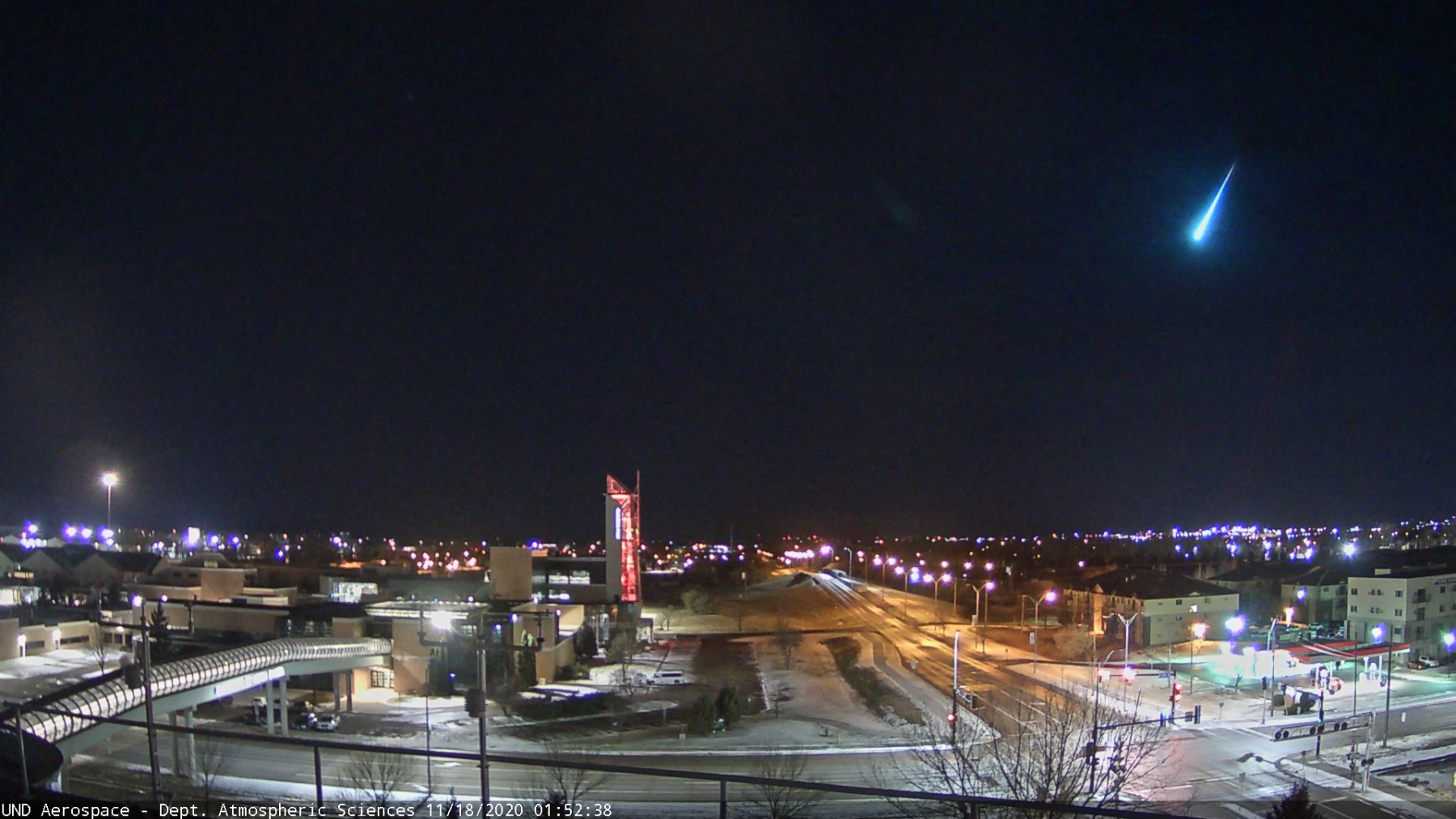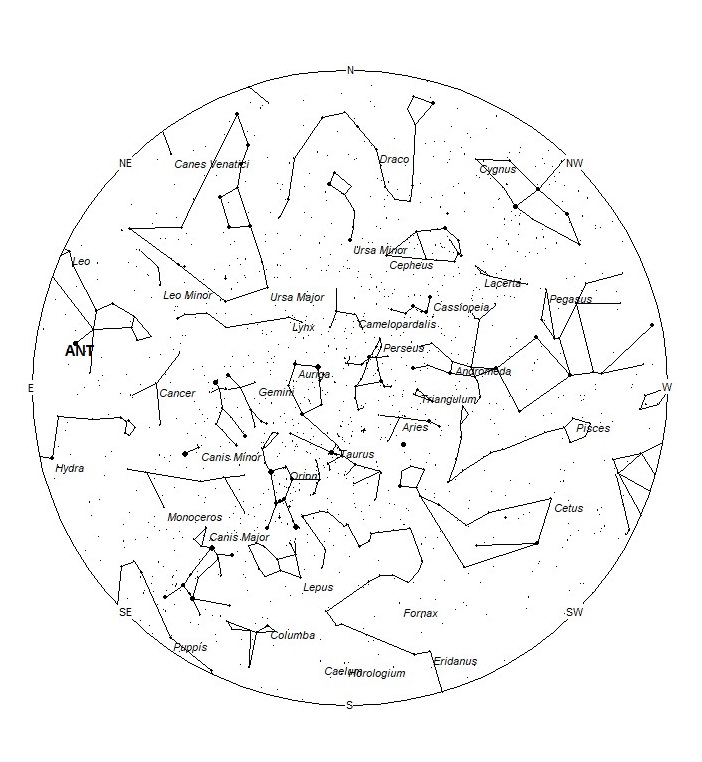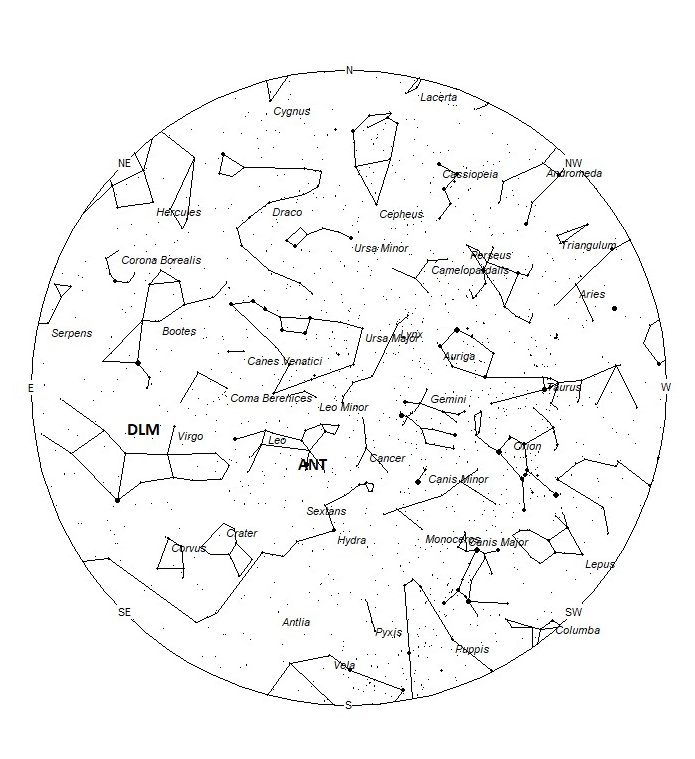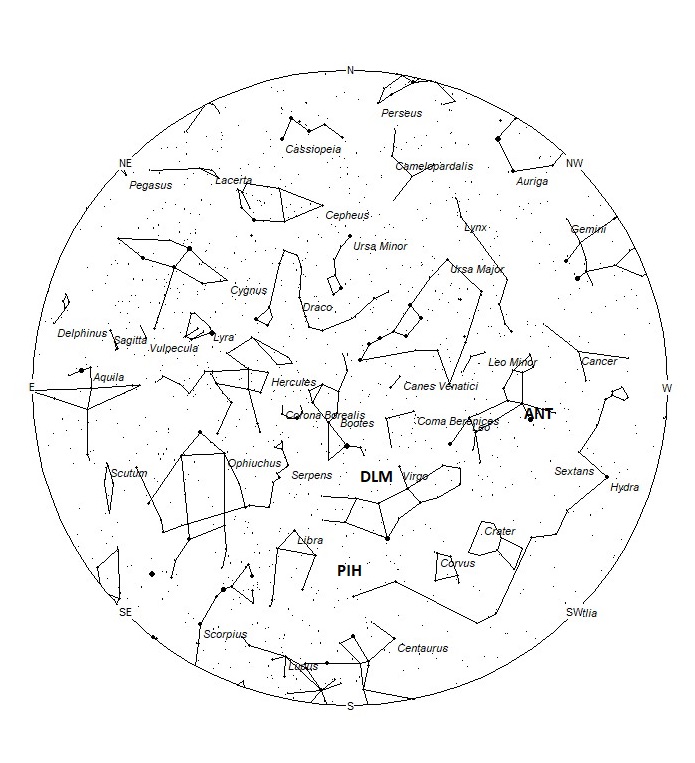
During this period, the moon reaches its new phase on Thursday February 11th. On that date the moon is located near the sun and is invisible at night. This weekend the waning crescent will rise during the early morning hours but will not cause any interference to viewing meteor activity as long as it is kept out of one’s field of view while observing. The estimated total hourly meteor rates for evening observers this week is near 3 as seen from mid-northern latitudes and 4 as seen from tropical southern locations (25S). For morning observers, the estimated total hourly rates should be near 8 as seen from mid-northern latitudes (45N) and 15 as seen from tropical southern locations (25S). The actual rates will also depend on factors such as personal light and motion perception, local weather conditions, alertness, and experience in watching meteor activity. Morning rates are slightly reduced during this period due to moonlight. Note that the hourly rates listed below are estimates as viewed from dark sky sites away from urban light sources. Observers viewing from urban areas will see less activity as only the brighter meteors will be visible from such locations.
The radiant (the area of the sky where meteors appear to shoot from) positions and rates listed below are exact for Saturday night/Sunday morning February 6/7. These positions do not change greatly day to day so the listed coordinates may be used during this entire period. Most star atlases (available at science stores and planetariums) will provide maps with grid lines of the celestial coordinates so that you may find out exactly where these positions are located in the sky. A planisphere or computer planetarium program is also useful in showing the sky at any time of night on any date of the year. Activity from each radiant is best seen when it is positioned highest in the sky, either due north or south along the meridian, depending on your latitude. It must be remembered that meteor activity is rarely seen at the radiant position. Rather they shoot outwards from the radiant, so it is best to center your field of view so that the radiant lies at the edge and not the center. Viewing there will allow you to easily trace the path of each meteor back to the radiant (if it is a shower member) or in another direction if it is sporadic. Meteor activity is not seen from radiants that are located far below the horizon. The positions below are listed in a west to east manner in order of right ascension (celestial longitude). The positions listed first are located further west therefore are accessible earlier in the night while those listed further down the list rise later in the night.
These sources of meteoric activity are expected to be active this week.
.
The Anthelion (ANT) radiant is active from a position located at 10:04 (151) +12. This position lies in western Leo, just west of the 1st magnitude star known as Regulus (alpha Leonis). This radiant is a very large oval some thirty degrees wide by fifteen degrees high. Activity from this radiant can appear from more than one constellation., This week these meteors can also be seen from eastern Cancer as well as western Leo. The position listed here is for the center of the radiant. This radiant is best placed near 01:00 Local Standard Time (LST) when it lies on the meridian and is highest in the sky. Rates at this time should be near 2 per hour as seen from the northern hemisphere and 1 per hour as seen from south of the equator. With an entry velocity of 30 km/sec., the average Anthelion meteor would be of slow velocity.
The December Leonis Minorids (DLM) are a shower of long duration active from December 1 through February 10th. Maximum occurred near December 20th. The radiant is currently located at 13:34 (204) +09. This position lies in northern Virgo, 6 degrees southeast of the 3rd magnitude star known as Vindemiatrix (epsilon Virginis). These meteors are best seen near 0500 LST when the radiant lies highest above the horizon. Current hourly rates are expected to be near less than 1 no matter your location. At 63 km/sec. the December Leonis Minorids produce mostly swift meteors.
The alpha Centaurids (ACE) are active from February 3-20, with maximum activity occurring on February 9th. The radiant is currently located at 13:54 (208) -58. This position lies in southeastern Centaurus, 3 degrees northwest of the 1st magnitude star known as Hadar (beta Centauri). Due to the southern declination of this radiant, these meteors are not well seen in the northern hemisphere. Current hourly rates are expected to be less than 1 as seen from the northern hemisphere and near 3 as seen from the mid-southern hemisphere. These meteors are best seen near 05:00 LST when the radiant lies highest above the horizon. At 56 km/sec. the alpha Centaurids would produce mostly swift meteors.
The pi Hydrids (PIH) were discovered in Dr. Peter Jenniskens and mentioned in his book Meteor Showers and their Parent Comets. Studies of the IMO video database by Sirko Molau and Juergen Rendtel confirmed the existence of this shower. These meteors are active from February 3-9, which maximum activity occurring on the 6th. At maximum, the radiant is located at 14:00 (210) -21. This area of the sky is located in extreme southeastern Virgo, 6 degrees northwest of the 3rd magnitude star known as Pi Hydrae. These meteors are best seen during the last dark hour prior to dawn when the radiant lies highest above the horizon in a dark sky. Rates at maximum are expected to be near 1 per hour as seen from the northern hemisphere. Rates as seen from the southern hemisphere could reach 2 per hour at maximum. These meteors are visible over most of the Earth, with the southern hemisphere having slightly better viewing conditions. At 55 km/sec. the Pi Hydrids would produce mostly swift meteors.
As seen from the mid-northern hemisphere (45N) one would expect to see approximately 6 sporadic meteors per hour during the last hour before dawn as seen from rural observing sites. Evening rates would be near 2 per hour. As seen from the tropical southern latitudes (25S), morning rates would be near 11 per hour as seen from rural observing sites and 3 per hour during the evening hours. Locations between these two extremes would see activity between the listed figures. Morning rates are slightly reduced due to moonlight.
The list below offers the information from above in tabular form. Rates and positions are exact for Saturday night/Sunday morning except where noted in the shower descriptions.
| SHOWER | DATE OF MAXIMUM ACTIVITY | CELESTIAL POSITION | ENTRY VELOCITY | CULMINATION | HOURLY RATE | CLASS |
| RA (RA in Deg.) DEC | Km/Sec | Local Standard Time | North-South | |||
| Anthelion (ANT) | – | 09:08 (137) +16 | 30 | 01:00 | 2 – 1 | II |
| December Leonis Minorids (DLM) | Dec 20 | 12:48 (192) +14 | 63 | 05:00 | <1 – <1 | II |
| alpha Centaurids (ACE) | Feb 09 | 13:54 (208) -58 | 56 | 06:00 | <1 – 3 | II |
| pi Hydrids (PIH) | Feb 06 | 14:00 (210) -21 | 55 | 06:00 | 1 – 2 | IV |
 American Meteor Society
American Meteor Society



I just saw a “fireball” moving west to east from Coral Gables, FL. Was this a meteor or rocket launch. Definitely not a plane or meteor. It was too bright with a fairly long tail.
Steven and All,
I did not find any rocket launches scheduled for that day and time. There are many reports of a fireball around 6:30pm EST that evening from Florida so I assume that is what you witnessed.
Thanks for this update. Tonight is the 9th. My wife and I were out on our front porch 2307 hrs in Connecticut. It just finished snowing a few hours ago with a total overcast with low clouds. Well I look up and what did I see? Couldn’t believe how low it was. You could literally see the fire ball burning and the tail was so long. It seemed to be 100 feet or so above the tree line. That was so cool right in front of us.
I’m not sure if what I saw would count as a fireball, but I think it was a meteor. I was at the corner of Essex Way and Payne Avenue in San Jose. I saw a bright burning light falling in the western sky at around 6:00 pm to 6:15 pm on Wednesday, February 10, 2021. It was bright and quick and left a bit of a trail in the sky after it burned up. It just lasted a second or two. It was a single light, about the brightness of a firework. Anyway, I didn’t report it as a fireball because I am not sure if it was big enough.
I think we saw a meteor on Feb 10, around 6.15 right outside Sacramento. It was spectacular. A massive fireball that burnt quickly leaving a trail of smoke in the sky. We were confused on what it was as we never seen anything like this before.
I just checked the pending fireball reports and there are many reports of a fireball over California around 6:15pm on February 10th.
Did anyone by chance get a video of this? Seeing that I missed this phenomenon, I’d sure love to see it!
Jeff and All,
So far we have received 15 reports, one photo of the persistent train, but no videos. The event page for this fireball is located at: https://fireball.amsmeteors.org/members/imo_view/event/2021/810
Just saw a large, bright comet/meteor very low in our atmosphere over Toronto, Ontario, Canada at 7:20 pm (approximate) lasted about 2 seconds and disappeared high up. Clear skies too… not lost in clouds
Saw a bright bluish-green fireball at about 1 am 02/24/2021 in Decatur Ga!
I saw a bright blue fire ball tonight Feb 26th 2021 round 10pm Mississauga Ontario Canada. It was coming down quickly lasted about 3 seconds and then disappeared. Crazy experience.